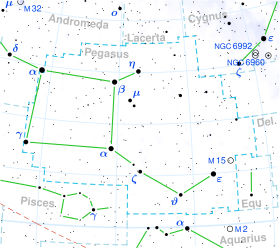Star in the constellation Pegasus
For other stars with this Bayer designation see π Pegasi
Pi Pegasi , Latinized from π Pegasi, is a star in the constellation Pegasus . Based upon changes to the proper motion of the visible component, this is a probable astrometric binary . It has a yellow hue and is dimply visible to the naked eye with a combined apparent visual magnitude of +5.58. The system is located approximately 319 light years distant from the Sun based on parallax , and is drifting further away with a radial velocity of +5 km/s. It is a member of the Ursa Major Moving Group of co-moving stars.
π Pegasi (right) and π Pegasi (left) in optical light The visible component is an aging giant star with a stellar classification of G8IIIb. It has a high rate of spin, with a projected rotational velocity of 135 km/s. This is giving it an equatorial bulge that is 17% larger than the polar radius. It is a shell star , being orbited by a circumstellar shell of cooler gas. This star is 530 million years old with 2.5 times the mass of the Sun . With the supply of hydrogen exhausted at its core , the star has cooled and expanded to 11 times the Sun's radius . It is radiating 63 times the luminosity of the Sun from its enlarged photosphere at an effective temperature of 4,898 K.
References
^ Brown, A. G. A. ; et al. (Gaia collaboration) (August 2018). "Gaia Data Release 2: Summary of the contents and survey properties" . Astronomy & Astrophysics 616 . A1. arXiv :1804.09365 . Bibcode :2018A&A...616A...1G . doi :10.1051/0004-6361/201833051 .Gaia DR2 record for this source at VizieR .
^ Anderson, E.; Francis, Ch. (2012), "XHIP: An extended hipparcos compilation", Astronomy Letters , 38 (5): 331, arXiv :1108.4971 , Bibcode :2012AstL...38..331A , doi :10.1134/S1063773712050015 , S2CID 119257644 .
^ Abt, H. A. (September 1985), "Visual multiples. VIII. 1000 MK types", Astrophysical Journal Supplement Series , 59 : 95–112, Bibcode :1985ApJS...59...95A , doi :10.1086/191064
^ Gontcharov, G. A. (November 2006), "Pulkovo Compilation of Radial Velocities for 35495 Hipparcos stars in a common system", Astronomy Letters , 32 (11): 759–771, arXiv :1606.08053 , Bibcode :2006AstL...32..759G , doi :10.1134/S1063773706110065 , S2CID 119231169 .
^ Takeda, Yoichi; et al. (August 2008), "Stellar Parameters and Elemental Abundances of Late-G Giants", Publications of the Astronomical Society of Japan , 60 (4): 781–802, arXiv :0805.2434 , Bibcode :2008PASJ...60..781T , doi :10.1093/pasj/60.4.781 .
^ Luck, R. Earle (2015), "Abundances in the Local Region. I. G and K Giants", The Astronomical Journal , 150 (3): 88, arXiv :1507.01466 , Bibcode :2015AJ....150...88L , doi :10.1088/0004-6256/150/3/88 , S2CID 118505114 .
^ Massarotti, Alessandro; et al. (January 2008), "Rotational and Radial Velocities for a Sample of 761 HIPPARCOS Giants and the Role of Binarity", The Astronomical Journal , 135 (1): 209–231, Bibcode :2008AJ....135..209M , doi :10.1088/0004-6256/135/1/209 , S2CID 121883397
"pi Peg" . SIMBAD Centre de données astronomiques de Strasbourg . Retrieved 2019-10-13.Eggleton, P. P.; Tokovinin, A. A. (September 2008), "A catalogue of multiplicity among bright stellar systems", Monthly Notices of the Royal Astronomical Society , 389 (2): 869–879, arXiv :0806.2878 , Bibcode :2008MNRAS.389..869E , doi :10.1111/j.1365-2966.2008.13596.x , S2CID 14878976 .
Schmitt, J. H. M. M.; et al. (March 1990), "X-ray studies of coeval star samples. III. X-ray emission in the UrsaMajor stream.", Astrophysical Journal , 351 : 492–499, Bibcode :1990ApJ...351..492S , doi :10.1086/168486 .
van Belle, Gerard T. (March 2012), "Interferometric observations of rapidly rotating stars", The Astronomy and Astrophysics Review , 20 (1): 51, arXiv :1204.2572 , Bibcode :2012A&ARv..20...51V , doi :10.1007/s00159-012-0051-2 , S2CID 119273474 .
Hauck, B.; Jaschek, C. (February 2000), "A-shell stars in the Geneva system", Astronomy and Astrophysics , 354 : 157–162, Bibcode :2000A&A...354..157H .
Slettebak, A. (September 1986), "H-alpha and near-infrared spectra of late-type Be and A-F-type shell stars.", Publications of the Astronomical Society of the Pacific , 98 : 867–871, Bibcode :1986PASP...98..867S , doi :10.1086/131836 .
External links
Categories :
Text is available under the Creative Commons Attribution-ShareAlike License. Additional terms may apply.
**DISCLAIMER** We are not affiliated with Wikipedia, and Cloudflare.
The information presented on this site is for general informational purposes only and does not constitute medical advice.
You should always have a personal consultation with a healthcare professional before making changes to your diet, medication, or exercise routine.
AI helps with the correspondence in our chat.
We participate in an affiliate program. If you buy something through a link, we may earn a commission 💕
↑

